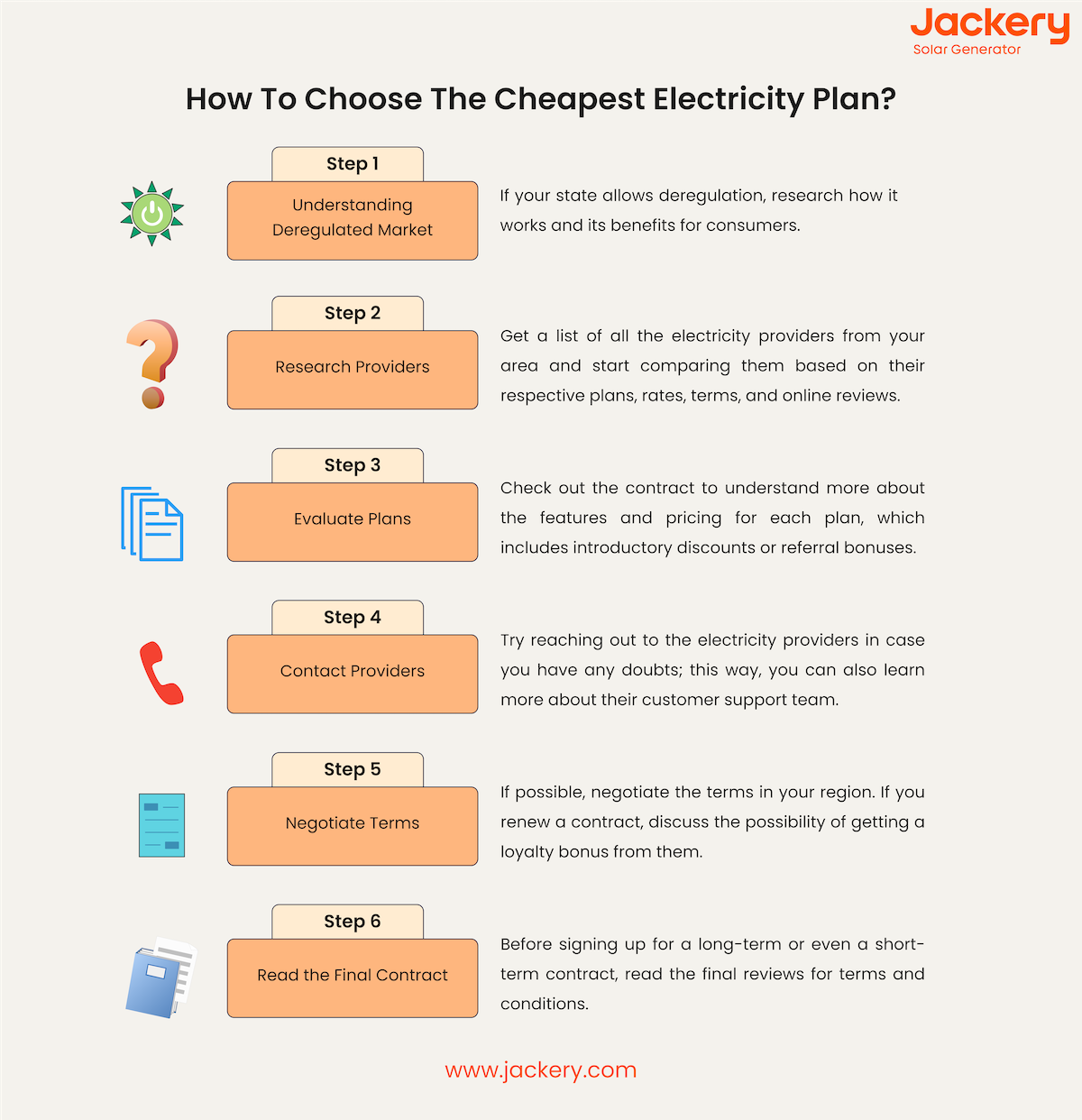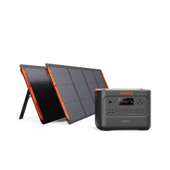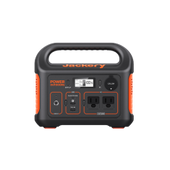Electricity rates in the United States depend on factors like energy provider, infrastructure cost, state, etc. Additionally, the electricity rate factors also depend on state taxes, deregulation of energy, and the use of renewable energy. Some states with cheap electricity plans are Nebraska, North Dakota, Idaho, and Louisiana.
Jackery offers a wide range of solar generators, solar panels, and battery backups that help reduce the monthly electricity bill without changing the number of electronic appliances that one might use concurrently. Additionally, the Jackery Solar Generators can charge most household appliances, making it a convenient choice for those looking to cut down on their monthly average electricity bills.
Top 10 States With Lowest Electricity Rates
As per a report by EIA, the average home in the US consumes 899 kWh[1] of electricity per month. The consumption rate varies as per state and also depends upon various other factors. For instance, electricity rates in North Dakota would significantly vary from New York due to the infrastructure and taxation.
Additionally, the United States uses different energy sources to generate electricity. Natural gas comprises 40% of the total energy source[2], followed by coal, which generates 18% of energy. Due to several incentives and rebate programs, renewable sources collectively provided roughly 22% of electricity, with wind contributing 10.2%, hydropower at 6.2%, solar at 3.4%, and biomass at 1.3%. Whereas, coal accounted for 18% of total electricity.
Renewable energy sources, such as hydropower, geothermal, wind, solar, and biopower, will have a significant role in the future electricity system in the US.
Here are the top 10 states in the US with cheap electricity plans:
|
State |
Electricity Rates in January 2024 |
Electricity Rates in January 2023 |
Increase / Decrease (% Change) |
|
Nebraska |
9.85 ¢/kWh |
9.35 ¢/kWh |
5.3 |
|
North Dakota |
9.88 ¢/kWh |
9.91 ¢/kWh |
-0.3 |
|
Idaho |
10.79 ¢/kWh |
10.58 ¢/kWh |
2.0 |
|
Louisiana |
10.82 ¢/kWh |
11.94 ¢/kWh |
-9.4 |
|
Missouri |
10.82 ¢/kWh |
10.73 ¢/kWh |
0.8 |
|
Utah |
10.85 ¢/kWh |
10.65 ¢/kWh |
1.9 |
|
Wyoming |
10.86 ¢/kWh |
10.28 ¢/kWh |
5.6 |
|
Washington |
11.09 ¢/kWh |
10.48 ¢/kWh |
5.8 |
|
Oklahoma |
11.16 ¢/kWh |
10.96 ¢/kWh |
1.8 |
|
South Dakota |
11.18 ¢/kWh |
11.25 ¢/kWh |
-0.6 |
Source: EIA[3]
What Are The Types Of Electricity Plans?
An electricity plan is a contractual agreement between a resident, commercial complex, or industrial building and a utility provider. It outlines the terms of electricity supply, electricity rates, and other contract details, including time, penalties, tax, etc.
Some of the most common types of electricity plans are:
Fixed-Rate Plans
Fixed-rate electricity plans are those in which a customer pays a fixed (or set) rate for electricity per kilowatt-hour throughout the contract term. For instance, if the contract is signed between a consumer and an electricity provider to pay 18.50 ¢/kWh, then the consumer will pay the said amount irrespective of market fluctuation.
Variable-Rate Plans
In variable-rate plans, there is no fixed rate that the customer has to pay; rather, there is flexibility, as electricity rates can depend on market conditions. For instance, the customer may pay a certain amount during off-peak seasons, but that amount might increase during the on-peak seasons.
Prepaid Plans
Prepaid electricity plans are those where the customer pays their monthly bill upfront. In these plans, consumers purchase a certain amount of electricity credits from the provider and later monitor their usage accordingly to avoid running out of the credit.
Time-of-Use Rate Plans
The time-of-use rate plans or TOU plans charge different rates for electricity consumption based on the time of day and season. For instance, the peak morning and afternoon hours typically will have higher rates, while off-peak hours, like after midnight or early morning, will have lower rates.
Now, most states in the US have deregulated electricity, which means that consumers have the option to choose cheap electricity plans or ones that meet all of their expectations. The electricity deregulation has created a more competitive market in the US, which led to lower prices and better service options for the end-users.
The following table provide a detailed overview of different electricity plans and would help the consumer choose the best option as per their budget and preferences.
|
Plan Type |
Description |
Pros |
Cons |
|
Fixed-Rate |
Offers a set rate per kWh for the contract term |
Predictable monthly bills |
Rates may be higher than variable plans during low-demand periods |
|
Variable-Rate |
Rates can fluctuate based on market conditions |
Potential for lower rates during off-peak times |
Higher rates during peak demand or market volatility |
|
Prepaid |
Pay for electricity upfront, similar to a pay-as-you-go system |
Flexibility to control usage and expenses |
Risk of running out of credit if not monitored regularly |
|
Time-of-Use (TOU) |
Charges different rates based on time of day and season |
Incentivizes shifting usage to off-peak hours |
Higher rates during peak demand times |
|
Renewable Energy |
Sources energy from renewable sources such as wind or solar |
Environmentally-friendly option |
May have slightly higher rates compared to traditional plans |
|
Incentive Programs |
Offers rewards or incentives for energy conservation and efficiency measures |
Encourages energy-saving behaviors |
Program eligibility criteria may apply |
How to Choose The Cheapest Electricity Plan?
With so many electricity providers and a wide range of electricity plans, it becomes confusing for several to choose the cheapest electricity plan for their requirements. Before finalizing the electricity plan or entering a new contract with an electricity provider, it's best to ask yourself a few questions, like:
- What is my average electricity usage?
- How many appliances do I intend to run concurrently?
- How many of my family members are going to use the electric appliances?
- At what time of the day are we going to use the most electricity?
- Do I have any specific preferences for renewable energy sources?
- Am I comfortable with a fixed-rate or do I want a variable-rate plan?
- Am I comfortable with a long-term contract term, or do I need a shorter one?
- What are all the contract terms that I need to understand?
- Have I checked for available incentives for energy efficiency measures?
- What is my monthly budget for electricity-related expenses?
Once you have answered all of these and similar questions, you can start picking the right or cheap electricity plans by adhering to the following steps:
- Understand Deregulated Market :If your state allows deregulation, research how it works and its benefits for consumers.
- Research Providers :Get a list of all the electricity providers from your area and start comparing them based on their respective plans, rates, terms, and online reviews.
- Evaluate Plans :Check out the contract to understand more about the features and pricing for each plan, which includes introductory discounts or referral bonuses.
- Contact Providers :Try reaching out to the electricity providers in case you have any doubts; this way, you can also learn more about their customer support team.
- Negotiate Terms :If possible, negotiate the terms in your region. If you renew a contract, discuss the possibility of getting a loyalty bonus from them.
- Read the Final Contract :Before signing up for a long-term or even a short-term contract, read the final reviews for terms and conditions. This would include thoroughly understanding contract length, cancellation policy, renewal terms, and other limitations.

How to Lower My Electricity Bills
Even if you are in a long-term contract or have chosen a variable-rate plan, there is always a way to reduce your average monthly electricity bill. By changing your daily lifestyle and routine, you can lower your bills and even promote energy efficiency in your home. Some of the ways that would assist you in lowering your electricity bills are:
Adjust Thermostat
Try setting your home or office thermostat to an energy-efficient temperature, such as 25°C in the summer and 20°C in the winter.
Replace AC Filters
Using old AC filters will increase your electricity bills, even if your provider has offered cheap electricity plans. Remember that a clogged filter can cause your AC system to work harder, increasing electricity usage.
Use Ceiling Fans
A typical household AC consumes 1000 - 1500 W, whereas a traditional ceiling fan typically consumes between 50 and 75 W. If possible, try opting for a ceiling fan over an AC in your region.
Unplug Electronics
Several household appliances, like coffee makers, induction, or even gaming consoles, sometimes consume electricity even when put on standby mode. It is always recommended to unplug such appliances when they are not in use.
Switch to LED Lighting
Try replacing the traditional incandescent bulbs with energy-efficient LED bulbs, which consume less electricity.
Consider Solar Energy
Several state governments have started incentive programs for residents who opt for solar energy. Investing in solar panels to generate your own renewable energy would reduce and, in some cases, eliminate your electricity bills.
Solar energy not only helps reduce monthly electricity bills but is also a great alternative to energy generated using coal and natural gas. Solar panels generate clean electricity without emitting greenhouse gases. Additionally, investing in solar technology offers long-term cost savings for homeowners through reduced electricity bills and potential incentives.
If you want to reduce your monthly electricity bill while charging almost all of your appliances, you can get Jackery Solar Generators. These solar generators are affordable compared to full-fledged installations, and you can even easily carry them during your off-grid adventures.
Jackery Solar Generators to Reduce Electricity Costs
Jackery is a renowned solar generator brand that has served more than 3 million customers around the globe. Jackery offers solar generators, solar panels, and battery backups built with the latest technology to help you save electricity. The high-capacity batteries of Jackery Solar Generators can charge up to 99% of your electric appliances.
The Jackery SolarSaga Solar Panels absorb the sun's rays and convert them into DC electricity via its monocrystalline silicon solar cells. The pure sine wave inverter then converts the stored electricity into AC current from where one can power household appliances, like air conditioners, room heaters, coffee makers, etc.
Jackery Solar Generator 3000 Pro
The Jackery Solar Generator 3000 Pro is equipped with an NMC battery and is functional in temperatures up to -20°C /-4°F. The large capacity battery and the support via a mobile application make it an ideal power supply for RVs, campaigns, glamping, home emergencies, or even when you wish to power your appliances without increasing the electricity consumption from the provider.

|
Solar Generator 3000 Pro |
|
|
Capacity |
3024 Wh |
|
Battery Cell |
NMC |
|
Cycle Life |
2000 cycles to 70%+ capacity |
|
Recharging Methods |
Solar Recharging : 3.5 H (6*Jackery SolarSaga 200W Solar Panels) Car Recharging : 35 H Wall Recharging : 2.4 H |
|
Output Ports |
AC Output (x1) : 120 V~ 60 Hz 25 A Max AC Output (x3) : 120 V~ 60 Hz 20 A Maximum USB-C Output (x2) : 100 W Maximum, 5 V⎓3 A, 9 V⎓3 A, 12 V⎓3 A, 15 V⎓3 A, 20 V⎓5 A |
|
Working Hours |
Electric Grill (1800 W) : 1.4 H Air Conditioner (1500 W) : 1.7 H Room Heater (1500 W ): 1.7 H Refrigerator (800 W) : 3.2 H Hand Blender (250 W) : 10.28 H Television (150 W) : 17.1 H |
|
Customer Review |
"The versatility of my Explorer 3000 kit, solar panels, and transfer switch allows me to live comfortably knowing I have a safety in place." -- James Brennan. |
Jackery Solar Generator 2000 Plus
The Jackery Solar Generator 2000 Plus is built with advanced IBC technology that lets it be fully charged in 2 hours when plugged with 6*Jackery SolarSaga 200W Solar Panels. This solar generator has a maximum power output of 6,000 W in parallel connection, which makes it ideal for off-grid living and powering your electrical appliances during extended blackouts.

|
|
Solar Generator 2000 Plus |
|
Capacity |
2-24 kWh |
|
Battery Cell |
LiFePO4 |
|
Cycle Life |
4000 cycles to 70%+ capacity |
|
Recharging Methods |
Solar Recharging : 2 H (6*Jackery SolarSaga 200W Solar Panels) Car Recharging : 25 H Wall Recharging : 2 H |
|
Output Ports |
AC Output (×4) : 120 V~ 60 Hz, 20 A Maximum AC Output (×1) : 120 V~ 60 Hz, 25 A Maximum USB-A Output (x2) : Quick Charge 3.0, 18 W Maximum USB-C Output (x2) : 100 W Maximum, (5 V, 9 V, 12 V, 15 V, 20 V up to 5 A) |
|
Working Hours |
Vacuum Cleaner (1500 W) : 1.1 H Room Heater (1500 W) : 1.1 H Dishwasher (1200 W) : 1.4 H Refrigerator (800 W) : 2.1 H Electric Drill (500 W) : 3.4 H CPAP Machine (60 W) : 29.0 H |
|
Customer Review |
"In conjunction while running appliances on propane, the 2000 Plus powered me through the night with heat and general lighting with power to spare the following morning." -- Chris K. |
Jackery Solar Generator 2000 Pro
The Jackery Solar Generator 2000 Pro is a compact and lightweight solar generator, ideal to power refrigerators, ovens, microwaves, etc. The lightweight design of Jackery Solar Generator 2000 Pro makes it perfect for road trips and off-grid camping.

|
Jackery Solar Generator 2000 Pro |
|
|
Capacity |
2160 Wh |
|
Battery Cell |
NMC |
|
Cycle Life |
1000 cycles to 80%+ capacity |
|
Recharging Methods |
Solar Recharging : 2.5 H (6 * Jackery SolarSaga 200W Solar Panels) Car Recharging : 24 H Wall Recharging : 2 H |
|
Output Ports |
USB-A Output (x2) : Quick Charge 3.0, 18 W Maximum AC Output (x3) : 120 V, 60 Hz, 2,200 W (4,400 W Surge Peak) USB-C Output (x2) : 100 W Maximum, (5 V, 9 V, 12 V, 15 V, 20 V up to 5 A) |
|
Working Hours |
Vacuum Cleaner (1500 W) : 1.2 H Room Heater (1500 W) : 1.2 H Dishwasher (1200 W) : 1.5 H Refrigerator (800 W) : 2.2 H Electric Drill (500 W) : 3.6 H CPAP Machine (60 W) : 30.6 H |
|
Customer Review |
"Well-made unit, easy to set up and use, very efficient. The SG2000 Pro is able to take care of all my off-grid power needs. The quality is outstanding." -- Mark Stewart. |
Cheapest Electricity Plans FAQs
Which electricity provider is the cheapest?
The cheapest electricity providers vary by location and plan options. Some of the notable electricity providers that offer cheap electricity plans are Flogas, Energia, SSE Airtricity, and Bord Gais Energy.
What is the cheapest electricity plan in Houston?
With 8.9 ¢/kWh[4], the Gexa Exo Choice 3 plan from Gexa Energy is deemed the cheapest electricity plan in Houston, Texas.
What is the cheapest electricity plan in Texas?
As of April 2024, the average electricity rate in Texas is 14.25 ¢/kWh[5], and the cheapest electricity plan available is Express Energy - Flash 12, which offers a rate of 10.7 ¢/kWh.
What state has the most expensive electricity?
With 44.28 ¢/kWh, Hawaii has the most expensive electricity in the United States, followed by Rhode Island, which offers electricity at 31.22 ¢/kWh, California at 29.49 ¢/kWh, Massachusetts at 28.34 ¢/kWh, Connecticut at 27.4 ¢/kWh, Maine at 25.89 ¢/kWh, New Hampshire at 25.07 ¢/kWh, Alaska at 23.78 ¢/kWh, New York at 23.44 ¢/kWh, and Vermont at 20.98 ¢/kWh.
How many kWh per day is normal?
The normal kilowatt-hour usage varies based on house size, appliances, energy efficiency, climate, etc. US residential customers typically consume an average of 899 kWh per month, equating to approximately 29 kWh per day.
Final Thoughts
There are several cheap electricity plans available in the United States, and several electricity providers offer the cheapest electricity rates to their long-term consumers. However, it is always recommended to carefully check all the terms and conditions before finalizing the electricity plan that suits your interest. If you are aiming to reduce your monthly electricity expenses without investing a hefty amount on solar panel installations, you can check out Jackery Solar Generators, as they are reliable and provide efficient solutions. With Jackery Solar Generators, you can charge 99% of your household appliances and even carry Jackery during your off-grid adventures.
References:
[1]:https://www.eia.gov/electricity/sales_revenue_price/pdf/table_5A.pdf
[2]: https://www.eia.gov/energyexplained/electricity/electricity-in-the-us.php
[3]:https://www.eia.gov/electricity/monthly/epm_table_grapher.php?t=epmt_5_6_a
[4]:https://www.puc.texas.gov/industry/electric/directories/rep/report_rep.aspx?ID=ELSQL01DB1245229100017
[5]:https://www.eia.gov/electricity/monthly/epm_table_grapher.php?t=epmt_5_6_a








































![[Add - on] Jackery Manual Transfer Switch for Explorer 5000 Plus - Jackery](http://www.jackery.com/cdn/shop/files/add-on-jackery-manual-transfer-switch-for-explorer-5000-plus-9017324.png?v=1754016782&width=170)


























































































Leave a comment